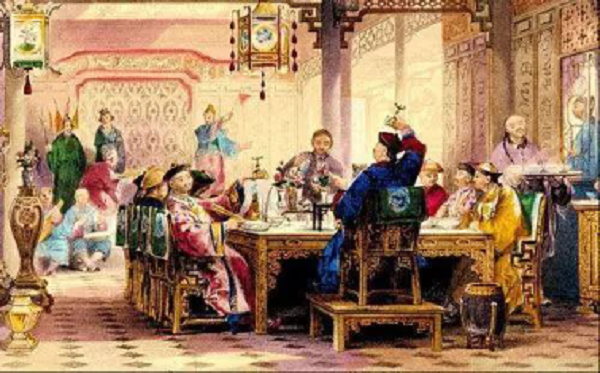
There were 10 cuisines with different cooking styles in the Qing Dynasty (1644-1911), including five from Nanjing, Suzhou, Zhenjiang, Yangzhou and Huai'an cities in Jiangsu province. Although those cities are close to each other geographically, each has its own unique food characteristics. In the Qing Dynasty, dishes were often carefully cooked by eunuch families.
In The Dream of the Red Chamber, an epic masterpiece in Chinese literature, there is a story about a dish in the chapter Grandma Liu visits the Grand View Garden. Jia's mother invited Grandma Liu to have dinner. When eating a dish, Wang Xifeng asked if Grandma Liu knew what it was. Grandma Liu shook her head and said she didn't know.
Wang told her it was made from eggplant and described the cooking process, "peel the eggplant, cut it into small pieces, fry it with chicken oil, and then cut a chicken breast, fresh bamboo shoots, mushrooms, spiced dried tofu and various dried fruits into small pieces, simmer them with chicken broth, dry it all up with sesame oil and seal it tightly in a porcelain pot. When you want to eat, take it out and mix it with boiled chicken breast. That's the eggplant you are now eating."

A stage photo of the 1987 version of The Dream of the Red Chamber.
What was the diet in the prince's mansion during the Qing Dynasty?
The daily diets of Manchu princes and nobles included morning tea, breakfast, dinner, and noon and night snacks.
The food in some prince's mansions was exactly the same as that in the emperor's palace. For example, Seng'er cake was made of flour with brown sugar, rock sugar crumbs and melon seeds. It was packed in two layers in small wooden cans and cooked over fire. Princes and nobles took this dish as a noon snack. In the Qianlong (r. 1736-1795) reign of the Qing Dynasty, Seng'er cake was served as the emperor's breakfast.
Also, snacks such as milk cakes and milk skins, a common food in Prince Kung's Palace, were served as cakes for dinner during the reign of Emperor Qianlong. In addition to a variety of dairy products, the custom of eating mutton and cabbage dumplings from the first to the fifth day of the Chinese Lunar New Year is also a tradition of Manchu people.

Catering of the princes' mansions was the responsibility of the kitchen and tearoom. Every year, the princes' chefs would prepare their dishes for the feast to be held in the Hall of Supreme Harmony on the eve of the Lunar New Year.
The biggest difference between prince's food and emperor's food was that the food in the imperial palace was made according to standard norms, and the recipes and production methods could not be changed. The meals in the prince's mansion were more personalized. Moreover, the cooks in the kitchen and tea room of the mansion had to guess the taste of the prince and gradually formed dishes with their own characteristics according to the prince's personality, cultivation and preferences.
Delicacies in Prince Kung's Palace
Wisteria cake, rose cake and Yuqian cake: when the flowers are in full bloom in spring, cut off fresh and tender wisteria, roses and Yuqian, wash them, add sugar and oil, mix them into fillings, make dough and wrap the fillings into it, then steam or bake the dough.
Lotus flavored assorted rice: in midsummer, choose lotus leaves with a diameter of about 7 inches, dice sea cucumber, winter bamboo shoots, ham, mushrooms, shrimp, pork, chicken breast and carrot, mix them with rice, add condiments, wrap the mixture in the lotus leaves and steam them over high heat for 30 minutes.
Cooking tea with lotus dew: make tea with the dew on the lotus leaves in the morning. It tastes fragrant and can be drunk in summer to reduce heat in your body.

Chinese wistaria at the Duofu Belvedere courtyard of Prince Kung's Palace